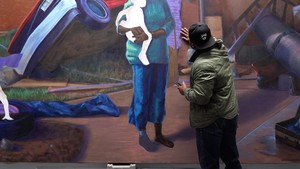If I rush, then I’ll have to start over.
I’ll have to untangle and double back, and more time will have been lost. If I focus—focus on this scalp that glows golden before me, focus on the geometrical patterns I’m making out of this hair, focus on the message trapped in these patterns like parchment in a storm-tossed bottle—then maybe we’ll make it out in time.
In the book, Pa’s saying to me: Hey, baby girl. Tell me what you want. You want the moon?
She doesn’t know what’s waiting for her. Even as the vanishing happens. Already, her shoes have lost their laces and tongues. They’re blocks of magenta on her feet. The vanishing has done the same to one of my sneakers. The other is creased and shadowed and lovingly lined. Like her.
She’s not scared, and I want to wrap this moment in my arms. I want to fit it as snugly between my knees as I fit her. I want to braid a warning into its hair.
You want me to tie this rope together and throw it up high in the sky? Pa’s asking me.
The creeping continues. The folds of my dress undo themselves. The fabric flattens.
Get that rope nice and tight around the moon.
I don’t know what this thing is that is taking her from me. But I’m braiding and watching her read about a father lassoing the moon for his daughter and hoping that these things are enough of a message for her when we are apart. That she will be able to decode these things and know that she is not alone.
Now, when I get you that moon, what are you going to do with it?
The book is losing its texture. The moon on its cover has vanished.
You’re gonna eat it?
She’s still here. With me. Sitting on the ledge colored green. The child has soaked up all of the sun so that all around her is deeply saturated color—the smudged emerald coloring the door and the floor and the plastic chair against the wall; the red of the portal to elsewhere; the row of blue stripes cutting diagonally across the door.
Well, if you swallow the moon, it’ll sit in your belly. Then it’ll break apart, then it’ll become like air inside you.
She has the cosmos in her. Wherever she’s going, she’s taking the universe with her.
I’m losing her.
It’ll shoot through your toes and your fingertips.
This is what it is like to live on the other side of the vanishing. To lose what was loved. Before, I was the lost thing, and now she must be the lost thing.
I’m almost done with her hair.
The moon will glow in your hair.
My fingers thread through absence.














